When Ratchet and Clank debuted on the PlayStation 2 nearly four years ago, it was already less of a platformer than those in the genre that preceded it. Kicking the cuter side of gaming into gear, the lombax and his lovable robot sidekick showed that their bias was in favor of heavy artillery instead of fancy moves. Now in their fourth iteration, Ratchet and Clank have upped the ante once again by removing almost all semblance of platformer gameplay to concentrate on combat. And though the game successfully reduces the jumping and swinging segments of the gameplay--due largely to Clank's retirement from action--the single-player is still, for all its changes, not that different from the previous three games. On the one hand, that works to the game's advantage, as Insomniac Games takes its already stellar gameplay mechanics and fine-tunes them with each addition to the series. On the other hand, it means that each successive entry in the franchise competes with all the previous games, so even the greatest devotees of the franchise will begin to tire of it. Thankfully, Ratchet: Deadlocked makes significant headway with revamped multiplayer and a brand-new co-op mode. Though the gameplay continues to remind us all too much of the previous games in the series, Ratchet: Deadlocked is still one of the best platformers you can find, with a clever story, unique and interesting weapons, and compelling multiplayer options.
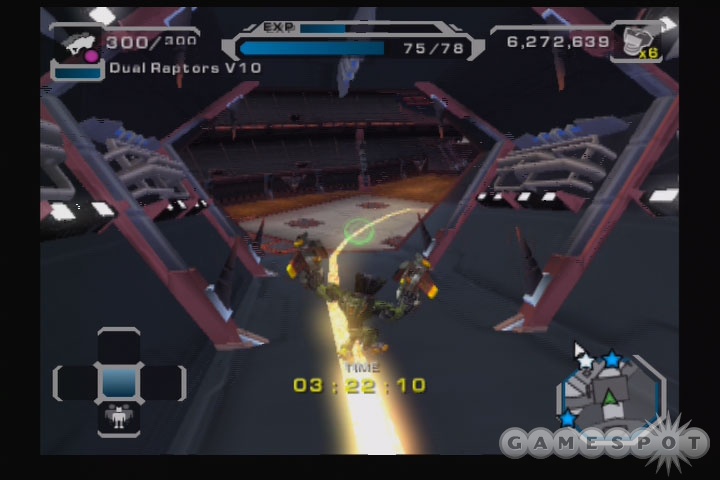
Ratchet: Deadlocked picks up shortly where Ratchet and Clank: Up Your Arsenal left off. The heroes--Ratchet, Clank, and the nerdy mechanic Al--are floating through space while basking in the spoils of their last efforts to save the universe when they are suddenly captured by nefarious evildoer and corporate tycoon Gleeman Vox. It seems that Vox, who's responsible for the trashy network Vox News, makes his living off a Running Man-style reality show called Dreadzone. Dreadzone pits captured heroes against one another...specifically by removing them from their arduous collective task of saving the world and forcing them to compete for bolts, fame, and, most importantly, ratings. Ratchet and Clank veterans might immediately draw comparisons between Dreadzone and Up Your Arsenal's Annhilation Nation, and those comparisons are not too far off base. Aside from the main characters and a few guest appearances, however, Deadlocked is a completely independent game. For as storied a history as Ratchet and Clank have together, there's surprisingly little tie in to the other games in the series.
Ratchet: Deadlocked maintains the same visual and aural standard set by the previous entries in the series. The game is smooth and beautiful, with bright colors, detailed environments, and splashy weapon effects. It's marred only by slight dips in frame rate, which become more noticeable in later segments when you unlock super-high-powered weapons and bonus visual effects. You'll be able to customize the appearance of Ratchet and both combat bots by unlocking and assigning differently themed armor. Even the most subtle changes made in the menus are immediately obvious in gameplay, a tribute to the game's strong visual style. The music and sound effects are still great, but the voice-over is what really gives the game its special flavor. Most of the levels are narrated by the two quirky Dreadzone announcers, Dallas, a sleazy egomaniac, and Juanita, a sadistic seductress. Their commentary about Ratchet, the competition, and each other persistently adds flavor to the gameplay. Arguably, the most entertaining aspect of the game takes place during the cinematics. The smooth cutscenes that progress the story by telling the tale of Gleeman Vox and his insane interests reveal the great personalities of the game's many characters, as well as the humorous ways in which they interact with one another.
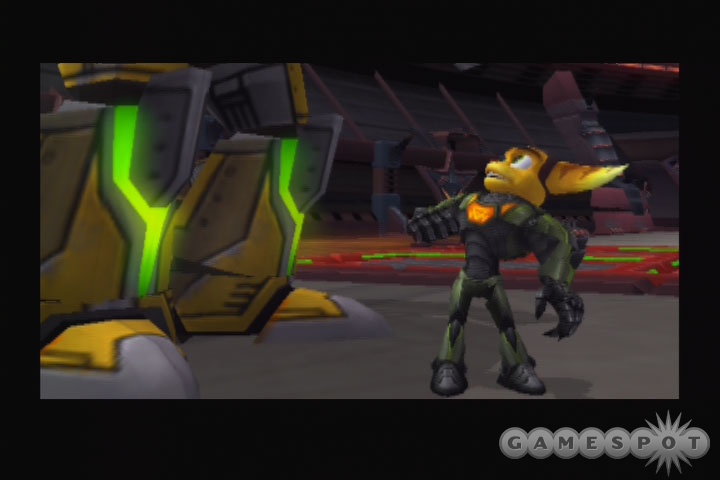
Once captured, Ratchet is suited up in Dreadzone attire, from head to his now-concealed tail. Clank is placed in charge of communications, and Al is given maintenance duties over Ratchet's new sidekicks: two combat bots. For the first time in the series, Clank is not perched on Ratchet's back. What this means for gameplay is that Clank's participation is confined to supplying gadgets (it's handled automatically, so you won't have to locate or earn them like in previous entries in the series). This also means there's almost no platforming to the game at all. From time to time you'll have to make your way across a few jumps, which is made trickier without the advantage of Clank's gliding capabilities, but those instances are few and far between. The swingshot and grindboots still make appearances on many of the levels, but the majority of the platforming-enabling mechanics and gadgets are gone. The consolation prize is the inclusion of the bots, which, courtesy of extremely adept artificial intelligence, follow you everywhere. Aside from providing extra force against enemies, they make excellent decoys and can be issued to complete various tasks, like tossing electromagnetic pulse grenades on electrically shielded enemies or bypassing "hacker orbs" found throughout the levels. Though the bots can die, they can be revived at any point during the game as frequently as necessary.
Without much platforming, combat takes a more critical role in gameplay. Aside from the wrench that Ratchet carries at all times, you can purchase up to 10 different guns. This is fewer than in the previous games, and you'll notice the artillery has been streamlined to include only the game's more-serious weapons. Each gun represents something semirealistic, whether it's the pistols, shotgun, or sniper rifle or the mine, grenade, turret, or shield launchers. The most absurd weapon in the game is the super-expensive Harbinger, which acts as this iteration's RYNO, the classically devastating gun from the first game. Even though some of the cooler guns are now MIA, you'll find that the remaining 10 are the most useful ones--and they have the potential to get quirky Ratchet-style upgrades.
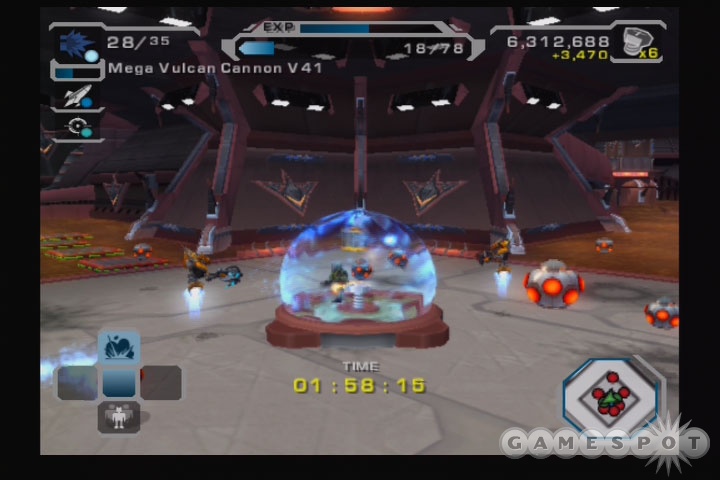
After frequent use, a weapon will automatically level up, which earns you an alpha mod for that weapon. Alpha mods boost certain attributes, like rate of fire or the gun's ammo capacity. Although not every alpha mod can be used on every gun, as you acquire more of them you can mix and match them to your liking (if the game's automatic placement doesn't suit you). You'll also be able to purchase alpha mods, but it's a waste of money until your second play-through, since the ones you receive automatically from leveling up are sufficient. Omega mods, on the other hand, give your weapons a little more punch and can be bought at any of the vendors. Each weapon can have at most one omega mod, but you'll be able to use the same one on multiple guns. Omega mods give flavorful attributes to the otherwise plain weapons in your arsenal. The frost mod freezes enemies upon contact and is the most useful of the omega mods. However, the morph mod, which lets you turn enemies into explosive barnyard animals (in lieu of the missing sheepinator), is definitely the most entertaining.
The combination of the alpha and omega mods makes your weapons both more effective and more stylish. Of course, weapon leveling doesn't just stop there. After you reach level 10 with your guns, which will take frequent use over the course of the entire game, they become superpowerful. The fusion rifle becomes the antimatter rifle, and the dual vipers become the dual raptors. And with the name changes come significant carnage. After completing the game for the first time and then beginning another one, the shop will carry a "mega" version of any gun that has reached level 10. Mega makes the guns even more powerful, and it ensures you'll be able to run through a second play-through while blasting everything in sight.
Of course, weapons aren't your only means of destruction, as Ratchet: Deadlocked also features a few different vehicle types as well. The one you'll encounter the most is the landstalker, a spidery contraption with both machine gun ammunition and explosive charged shots. In the landstalker you'll be able to dispose of larger enemies more quickly, and you'll get past obstacles that can only be bypassed using the charged shots. From your perch in the landstalker, you can still command the combat bots to do many activities, which will prevent you from having to keep getting in and out of the vehicle to do them yourself. The puma is a buggy of sorts; the hoverbike is a floating motorcycle; and the hovership is an air-based vehicle that isn't used nearly as much as it should be during the single-player game. All these vehicles can be used during the multiplayer, although they do tend to unbalance the gameplay significantly, given how strong they are.
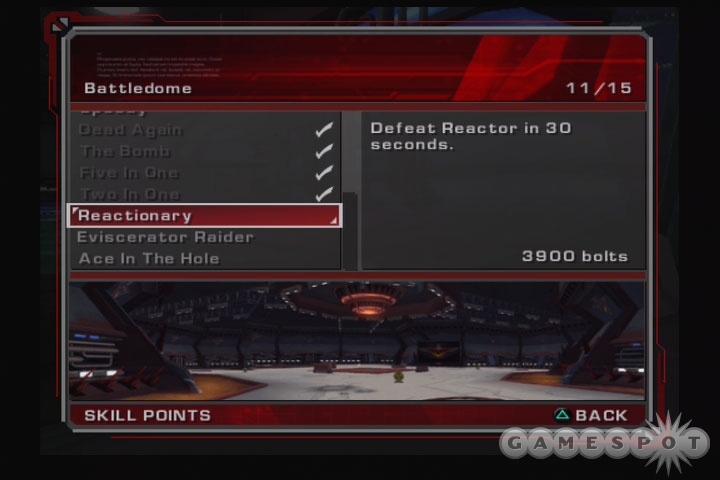
The gameplay occurs in 11 different locales, including 10 planets and the Dreadzone battle station, a gladiatorial-style arena where you compete in tournaments to upgrade your contestant ranking. Most of the gameplay occurs on the 10 planets in the form of linear challenge-driven campaigns. As the latest hero to be forced into Vox's terrible enterprise, you'll need to make your way through objectives while staying alive and protecting innocent bystanders whenever possible.
Aside from these required objectives, there are also dread challenges, which aren't part of the story per se, though they give you necessary experience points to unlock additional planets. Dread challenges are usually time-limit or arena-based missions that take place in the location you just campaigned. Mix in the skill points, 15 off-the-beaten-track tasks on every planet, and there will be a fair bit to do before you reach 100 percent completion. Skill points are acquired from side quests, such as those that require you to "shoot down 15 of the floating TV cameras" or "kill two enemies with one mine-launcher." You'll get a few of them during the course of natural gameplay, but you'll probably need to look them up specifically to get them all. Getting skill points unlocks additional content that can be found in the "extras" menu, such as the ability to turn on interesting and absurd weather effects or "super bloom," which is an apparent dig at the effect's overuse in video games. There is, in fact, a ton of extra content, although most of it is for aesthetic purposes and can't be carried over to the multiplayer gameplay. You can use the game's currency--bolts--to buy practical things like weapons and modifications, or you can simply buy up different customizations for Ratchet and the combat bots' appearances.
The problem is that despite all the extra cool stuff you can get, most of which you'll encounter during a second play-through, the game is, unfortunately, much shorter than previous Ratchet offerings. The single-player campaign will take approximately seven or eight hours to complete. Afterward you'll unlock challenge mode, which changes some of the rules of normal gameplay, but not enough of them to warrant playing through a second time. It's neat to check out the higher difficulty modes, and although the normal (or contestant) mode is fairly simple, the exterminator mode is very challenging. Those familiar with the series should try to kick up the difficulty a notch early on, since otherwise you'll breeze through the gameplay with little reason to play a second time, aside from completion. Although the game saves after every challenge, if you die before finishing one, you'll start at the beginning again. This is only a problem on the longer and more difficult segments of the game. But usually after a few tries, you can get through any mission.
The game's surprisingly short length is thwarted by its rich multiplayer modes. For the first time ever, you'll be able to play the game cooperatively, which means that any point during the single-player you can opt to play co-op by having a friend jump into the game. Playing two-player co-op means you don't get to have combat bots anymore, but both players will be given all the bots' capabilities, like use of the hacker ray and EMP grenades. In co-op you won't be able to use the same weapon at the same time, since you'll be sharing the same arsenal, but all collected ammunition and bolts will be available to both players. The one interesting twist is that you can't stray too far from each other, because once you reach a certain distance, the game begins a countdown timer. Upon reaching zero, you are both killed, and you must both begin the mission again. Since you must stay close and share weapons, co-op demands a high level of communication, especially on levels where you share a single vehicle (like the landstalker) and each control different guns. Co-op is also unique, because as long as one player stays alive, the game can continue. After each death, you'll have a short respawn time, during which the other player must stay alive or risk losing the mission.
There's also offline and online competitive multiplayer with four- and 10-player limits, respectively. In addition to Up Your Arsenal's deathmatch, capture-the-flag, and siege (now known as conquest) modes, the game now includes juggernaut and king of the hill. Deathmatch and capture the flag should be familiar to anyone who's played a multiplayer shooter before. Conquest is a fairly in-depth base-capturing mode that's very much like onslaught from Unreal Tournament 2004. Juggernaut turns one player into an all-powerful character that everyone else must attempt to take down, and king of the hill requires that opposing teams compete for control of a specific target zone. The multiplayer is broadband only, but the resulting experience is quite satisfactory, so long as you can find enough people to play it with. In the multiplayer menus, you'll be able to play on 11 different maps taken directly from the single-player levels, in addition to being able to turn vehicles on or off, customize the weapons and availability of mod pickups, and tinker with the usual time-limit and frag-limit tweaks typically found in multiplayer games. You'll also be able to communicate with other players via headset or through text using either the PlayStation 2's USB keyboard or the onscreen mock-up.
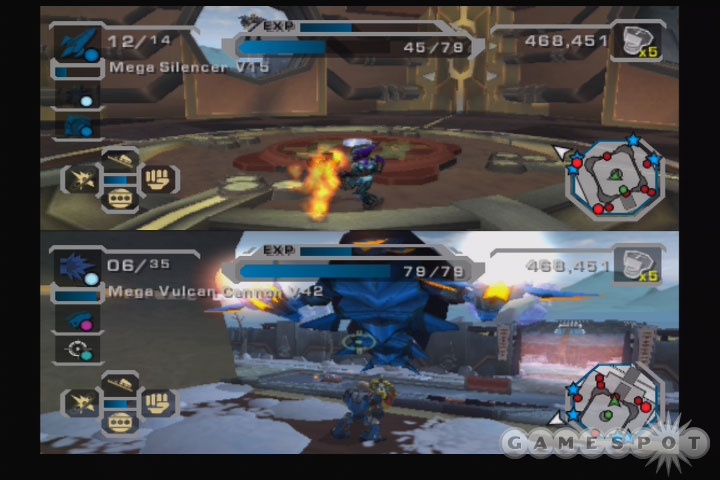
The multiplayer isn't exactly innovative, but it does a great job of fluidly combining typical shooter fare with the quirky Ratchet and Clank universe. Of particular note is the way that the weapons have multiple uses. You can launch the heat-seeking mines near opponents and it will target them, or leave mines in highly-trafficked areas. You can even make contact with another player while the mine is still sitting in the launcher. Although you can do this in any of the gameplay modes, it's the ability to do derive multiple functions from one weapon, when you might not have found any others, where it's most useful. The maps are a fairly good size for any number of players that might be online, thanks largely to the minimap, which becomes particularly beneficial in multiplayer. Although the multiplayer isn't outstanding, it's deep and varied enough to keep you hooked for quite awhile, perhaps for even longer than the single-player mode.
Ratchet: Deadlocked is a little on the short side, and it's quite a bit like previous games (to the point of feeling all too familiar). But all in all, it's an excellent game that combines humorous presentation, stylish weaponry, and a ton of different modes into one cohesive package. If you like the idea of weapon-centric gameplay with a charming platformer twist, this game will be a welcome addition to your collection.